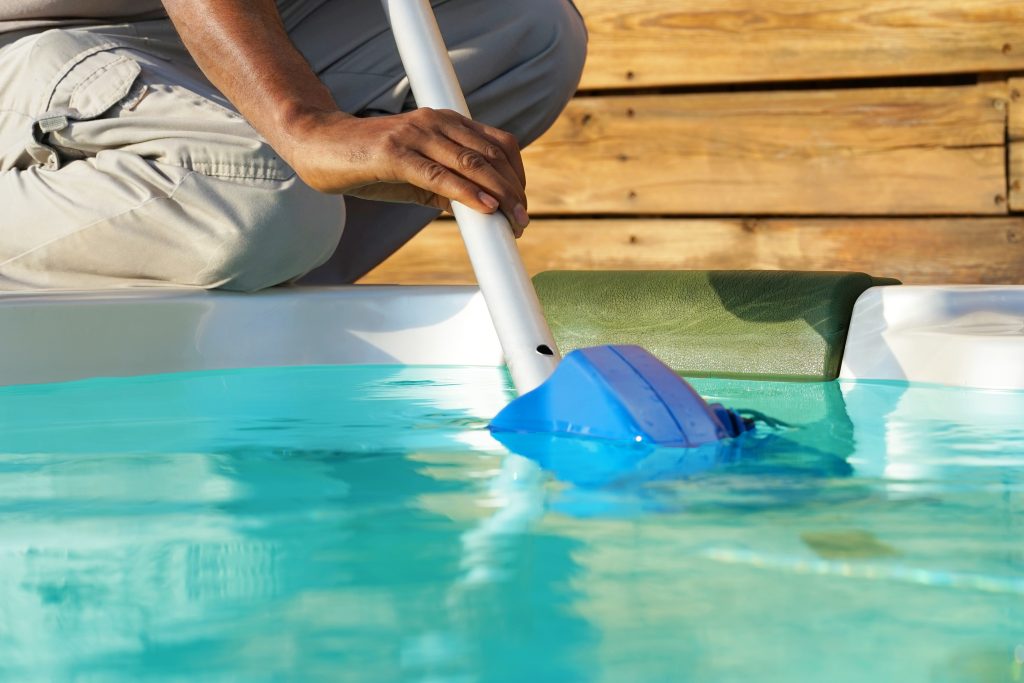Having a pool is a great way to relax and entertain, but it can also be a lot of work to maintain. That’s why it’s important to understand the basics of swimming pool maintenance so that you can keep your pool looking and functioning at its best.
In this guide, we’ll look at the important aspects of pool maintenance and provide you a pool maintenance checklist, including how to test the water, how to clean and maintain the pool filter, and how to properly treat your pool water. We’ll also discuss some tips on how to save time and energy with your pool maintenance routine.
By following these guidelines and taking good care of your pool, you’ll be able to enjoy a clean, safe swimming experience for many years to come. If this is too much for you, we’re always there to help. Connect with us for best cleaning and pool maintenance in Delhi.
Must-Have Pool Supplies
To make swimming pool maintenance a breeze, it’s essential that you equip yourself with the right supplies. Not only are the right tools important for proper cleaning and maintenance, but they will also save you time and money in the long run. Here’s a quick overview of must-have pool supplies:
- Pool Vacuum: A great way to clean up debris from your pool is with a vacuum. Pool vacuums come in both manual and automatic varieties, so find what’s best for your pool setup.
- Skimmer Net: Skimmer nets are essential for removing leaves, bugs, and other debris from the surface of your pool quickly and easily. This is especially important if you live in an area with lots of trees.
- Pool Brush: A stiff-bristled brush can help remove tough dirt from the sides and bottom of your pool – something pool vacuums cannot do.
- Chemical Test Kit: Testing your water regularly is one of the most important steps when it comes to keeping your pool clean and safe to swim in. Make sure you have a chemical test kit on hand at all times to easily monitor pH levels and other water chemistry parameters.
Daily Swimming Pool Maintenance Checklist

Every swimming pool should be consistently maintained—not only to keep it safe and hygienic but also to prevent costly repairs or replacements down the line. A few basic pool maintenance tasks you’ll need to do regularly include
Checking chemical levels
pH and alkalinity should remain balanced in order to make sure that the water is safe. The chlorine level also needs to be monitored in order to ensure that it’s sufficient enough to protect against bacteria, algae, and other contaminants.
Skimming the surface
This prevents any organic material from sinking down and causing problems with your filtration system. It also improves the water’s esthetics.
Brush the walls
Regular brushing with a pool brush keeps dirt from accumulating on the walls and can reduce staining, which sometimes causes permanent discoloration of the pool surface if left untreated.
Vacuum debris
Leaves, grass, pollen, and other debris can clog up your filters, making them less efficient at cleaning your pool water. Vacuuming gives your filters an extra break by removing such debris before they have a chance to enter the system.
How to Balance the pH Levels in a Swimming Pool
Balancing the pH levels of your swimming pool is important in order to make sure your pool water is safe, comfortable, and free of pollutants. The ideal range for pH levels in a pool is between 7.2 and 7.8 on the pH scale. If the waterfalls outside of this range, it can become corrosive, leading to scaling of the plumbing system, staining on the tiles, and skin irritation when swimming.
Luckily, balancing your pool’s pH levels is simple and easy to do with a few simple steps:
- Test the pool water using a chlorine test kit or strips.
- Use shock treatment and algaecide as necessary.
- Use an appropriate amount of pH increaser or decreaser to adjust the acidity level.
- Retest the water after 24 hours to ensure that you have achieved the desired pH level.
- Add stabilizer or conditioner if needed.
By following these steps, you will be able to keep your pool’s pH levels balanced and ensure that everyone who uses it can swim safely with no worries about skin irritation caused by high or low acidity levels.
How Often to Clean Your Pool Filter
Pool filters work hard to keep your pool clean and healthy, so it’s important to maintain them properly. Cleaning your pool filter should be done on a regular basis to ensure that the water stays clear and free from dirt, debris, and other contaminants.
How often you should clean your filter will depend on the type of filter you have and how heavily it is used. As a general rule, it’s recommended that you clean your filter every three to four months.
For sand filters, backwash or reverse flow the filter every two weeks or when pressure builds up around 10 psi above the normal pressure reading. For cartridge filters, replace the cartridge every two years or when pressure builds up around 10 psi above the normal pressure reading. For DE (diatomaceous earth) filters, backwash or reverse flow DE filters when needed and add new DE powder when needed.
By following these regular cleaning guidelines, your pool water will stay sparkly clean, and safe all season long!
Weekly Pool Maintenance Checklist
Keeping your swimming pool clean is an important part of its maintenance. Here are a few tips to help you keep your pool clean
Skimming
Skim the surface of the water regularly to remove debris such as leaves, twigs, and other organic matter that could get trapped in the filtration system. Skimming should be done at least once a week, but more often if your pool is located in an area with lots of trees.
Vacuuming
Vacuum the bottom of the pool to remove dirt and debris. This needs to be done regularly—ideally at least once a week, but more often if you notice any build-up of dirt or algae.
Testing and Balancing the Water
Chemical testing should be done regularly to ensure optimal chemical balance. pH levels should be tested at least twice a month, while other chemicals, such as chlorine, can be tested weekly. It’s important that these levels are maintained regularly for a healthy and safe swimming environment.
Cleaning Walls and Flooring
Using an appropriate cleaning product, brush down walls and scrub any tiles or finishes on the flooring of your pool. This will help prevent build-up from occurring and keep your pool looking pristine all year round.
Annual Pool Maintenance Checklist
Winterizing the Swimming Pool
Winterizing your swimming pool can seem like a daunting task, but it’s necessary to ensure the longevity of your equipment and to avoid costly repairs.
Cleaning and Closing The Pool
The first step in winterizing your pool is to clean it thoroughly. Make sure you scrub the walls and floors, removing any algae or dirt that have gathered. You’ll also need to balance the chemical levels in the pool, lower the water level by about 4 inches, and add special winterizing chemicals to protect your pool from algae growth during colder weather.
Once you’ve finished cleaning, cover up your pool with a winter cover designed for outdoor swimming pools. This will help keep debris out of the water, as well as prevent unwanted visitors from trying to take a swim! You can also use a floating cover for added protection.
Winterizing Your Equipment
Next on your list should be winterizing all your pool equipment. Drain all filters and pumps to prevent them from freezing over during colder months. You should also blow out any pipes or hoses that are connected to the pump and filter systems using an air compressor or shop vacuum – this process is known as “winterizing.” Finally, ensure that any backup heaters are turned off before you store away anything else in preparation for winter weather.
By taking these steps each year, you can guarantee that this winter will be more pleasant when it comes time to open up your swimming pool again next year!
Conclusion
Taking care of a swimming pool is more than just occasionally making sure the water is full, and the chemicals are balanced. It requires regular maintenance and upkeep to ensure that it is always in top condition. To keep your pool in ideal shape, you should regularly check the pH levels, clean the filter, and vacuum the pool as needed. Additionally, you should also check for leaks, perform daily equipment checks, and ensure the pool is free of debris. Doing all of this will help keep your pool safe and enjoyable for friends and family to use. Keep these simple tips in mind when it comes to pool maintenance, and you will be able to enjoy a pristine pool all season long.





